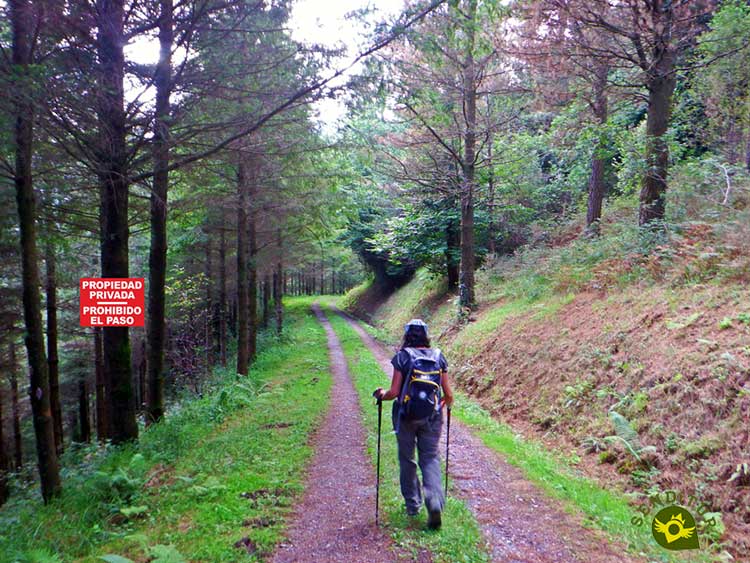Surely, on some occasion when you were walking along a road or a trail in one of those beautiful hiking trails that you usually do, you have come across a sign of the type "prohibited the passage, private property". Something that unfortunately is becoming more common every day, and we are not talking about fences or gates to prevent livestock from escaping from a particular area, far from it. Nowadays there are quite a few places where we have prohibited the passage down roads and paths and that previously could be traveled without any problems.

This is a more common problem than it might seem, and one that is difficult to solve once we encounter the little sign in question.
No, although most of us were positively influenced by the slogan "the mountain belongs to everyone, take care of it" belonging to an old advertising campaign that sought to protect nature, the mountain generally does not belong to everyone, it has its owner. That is why in some cases these signs, gates and fences are doing their job correctly. Although it is no less true that in other cases it is forbidden to pass through public roads or with right of way that cross or border with private properties, whose owners for whatever reason have appropriated it or impede the transit without being able to do so.

A problem, that of these prohibitions, which is intensifying in recent times. And it must be recognized that if this spectacular place to which a route leads has been preserved in perfect condition over the years, it is partly due to the small influx of people who visited it. Influx that in recent times has increased considerably in some cases, and unfortunately not all people respect the environment through which they pass. This may be one of the reasons why a road that previously had no sign or fencing preventing the passage now if you have it, paying the righteous for sinners as usual.
In Spain we have a wide network of public roads, without forgetting the paths and historic trails that allow us to enjoy nature while we travel them, Many of them are approved routes or promoted by public entities, in these cases before proceeding to its approval, signaling or dissemination, have gone through the corresponding technical authorizing its development verifying among other things that its route does not infringe the rights of the owner of any private property. That is why, initially, we should not have any problem with these routes, although unfortunately this is not always the case. Another very different thing happens with unofficial routes, here surely no one has verified whether the road is public or not. And as we have already mentioned, there are many people who believe that the mountain belongs to everyone.

The first thing to know is that if a road has been public, for example, 100 years ago, that road will remain public today, regardless of whoever it may concern, although we know that exceptions can always be made if the public administration deems it necessary. Although it seems clear, simple and easy to solve it is not, we will not go into laws, royal decrees and legal terminology, we will try to give you some guidelines so you can get out of doubt or at least clarify a little:
All town halls must have an inventory of public roads. This inventory is supposed to be carried out to avoid the misappropriation that in many cases occurs on roads and trails, and to protect this heritage. This is where if we have doubts we can go directly, although unfortunately not all municipalities currently have this inventory.
As we already know, Spain has a wide network of cattle routes that should also be catalogued by the corresponding autonomous community for public consultation. The problem is that the vast majority of these cattle routes have been lost or have been improperly included within private property.
The banks of rivers and coasts, 5 meters on each side of the maximum flood in the case of rivers and 6 meters on coasts (excluding the coastal law), are always public land. Here we are sure to be assaulted by countless defaults...
We also have available the Geographic Information System for Agricultural Parcels, SIGPAC, which is a web site that allows to identify geographically the plots and to know if they are of public or private use, among many other functions. This viewer similar to Google map delimits all the plots and roads; if we select one it provides us with numerous data, including a numerical code corresponding to its identification in the cadastre, if this number is between 90000 and 99999 initially it means that it has tax exemption and therefore it is not private, although the cadastre does not work the same in all Spain and this reference may not be entirely correct.

As you can see, a simple poster can easily make our day bitter, unfortunately there are many abuses of this type that we can of course report to the public administration, although it usually takes a long time to solve them.
Before getting into a dispute that usually leads nowhere it is preferable to have a little left hand with the owner on duty, surely we will get more than if we start taking out of the backpack old laws and cadastral records.
If the route is not official, it is a good idea to take a look at the route through the SIGPAC viewer when you prepare it.
Use common sense, respect nature, animals and the environment around you. Just because everyone is on a road or trail doesn't mean it's right to do so.
We would be grateful if you could write to us to inform us of any erroneous or outdated information you have found, or simply to let us know what you think at Thank you very much.